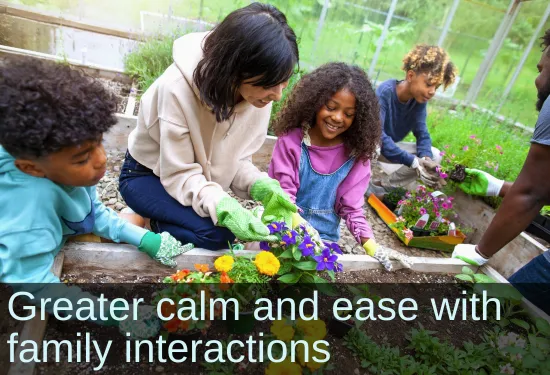Primitive Reflex Integration Case Studies
OT Finds Neurodevelopmental Movements Beneficial for Anxiety
Rhythmic movements and reflex integration help occupational therapist improve self-regulation
This therapist and mother of three was often dysregulated, particularly during high-demand times such as coming home from school. She experienced anxiety, and her communications with family members weren’t always as loving as she intended. See how using rhythmic movements, reflex integration, and the 5-Step Balance process from the Brain and Sensory Foundations, First Level course brought greater calm and ease to her daily life.
Submitted by S.M., Occupational Therapist

| Before | After |
|---|---|
| Perfectionist | Has learned to give herself grace |
| Difficulty remaining calm and well-regulated in stressful moments, especially with family | More often able to remain loving, present, and calm with family |
| Easily triggered; often resorting to yelling, nagging, or controlling | More in touch with internal feelings, and thus able to replace stress and negativity with calm and positivity |
I am a 40-year-old OT and mom of 3 kids. One of my biggest challenges is my anxiety and perfectionism. I often have difficulty remaining calm and well-regulated in stressful moments with my own family members. I find that I am often easily triggered by my family not listening, and sometimes resort to yelling/nagging/controlling more than I would like. My goal is to be able to regulate my own internal state better, so that I can remain calm and positive when interacting with others.
I focused a lot on the Brain Tune Ups to get myself ready before working with my child. I really wanted to get my own body regulated before even beginning to help anyone else. The heart-brain connection [from the Brain and Sensory Foundations course] was also something I focused on to try to change my often negative thoughts into positive, loving ones when working with my child. I chose to utilize these two tools first in order to better meet my goal of reducing my own stress and anxiety, and having more peaceful interactions with my family members. In addition, I practiced all of the rhythmic movements in order to calm my system. During this course, I realized that I show several signs of an active Moro reflex, even though I did not show any response to the reflex stimulation. I am frequently stressed, on edge, easily overstimulated, and quick to lose my temper with my husband and children. Therefore, I decided to integrate Moro [using techniques from the Brain and Sensory Foundations course] to try and meet my goals.
I definitely noticed that I felt much calmer after the Brain Tune Ups, rhythmic movements, and Moro reflex integration activities. The heart-brain connection was extremely useful for me when working with my child on her own movements, because it allowed me to focus on having a positive, loving attitude. The more I have practiced using these tools, the more I have found myself paying attention to my own internal state. When I notice myself feeling stressed, I can now usually catch myself and take a break to use these tools and movements to help calm down faster. I am still not perfect and have my moments, but with practice I am improving.
I have learned to give myself grace, and take time to focus on my own self-care. I often find myself getting so caught up in taking care of others that I forget how important it is to take care of myself too. My own internal state can greatly affect those around me, so I have to be calm and regulated before I can expect my children to do the same.
I have been using these tools for about 3 months now, and will continue to do so. I practice these tools and movements for a few minutes each day, sometimes more when needed.
I used the 5-Step Balance Process [from the Brain and Sensory Foundations course] to help me with my goal of reducing stress and being more present and loving with my family members.
Specifically for this case, I chose for my goal to be “I am remaining loving, present, and calm with my family after work and school.” The late afternoon/early evening when everyone gets home is often the most stressful for me as we are juggling after school activities, homework, and dinner. That is why I chose this goal. I went through each step of the balance, and engaged in Moro reflex activities. Afterwards I did find that I felt less overwhelmed, was calm and ready to set the stage for a peaceful after school environment at home. The biggest impact this had on me was just to notice how I’m feeling internally more often, so that I can replace my stress and negativity with a better sense of calm and positivity.
(Edited, emphasis added)
*Disclaimer: The activities in the Brain and Sensory Foundations curriculum make use of the natural processes of neuroplasticity and development that are innately wired in the design of human beings to promote maturity and function. These activities appear to calm, organize, and mature the neuro-sensory-motor systems just as we see in the healthy development of human infants. Individual results may vary, and we do not claim to offer a diagnosis or cure for any specific condition or disorder. The Brain and Sensory Foundations activities appear to improve overall functioning resulting in measurable improvements for a range of conditions as demonstrated in over 1800 case studies from participants.

